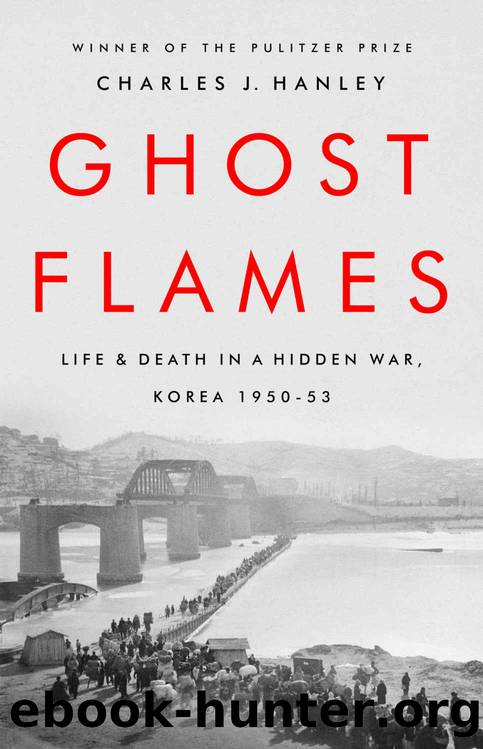Ghost Flames by Charles J. Hanley

Author:Charles J. Hanley [Hanley, Charles J.]
Language: eng
Format: azw3
Publisher: PublicAffairs
Published: 2020-08-24T16:00:00+00:00
MARCH
WEDNESDAY, MARCH 14, 1951
Matt Ridgway’s army recaptures Seoul
Word comes in to General Ridgway’s Eighth Army operations staff: a patrol from the ROK 1st Division has raised the South Korean flag over the capitol dome in Seoul. The city has been recaptured once again, this time with no opposition, in contrast to the bloody, smoke-filled days of block-to-block firefights of last September.
The South Koreans and the U.S. 3rd Infantry Division began sending patrols across the Han River on Monday. They found more and more defensive positions abandoned by the North Koreans and Chinese. Probes east and west of the city also are advancing without seeing enemy. Air observers report spotting enemy defenses being built several miles north of Seoul. Ridgway will order his own troops to establish a defense line just north of the city.1
The Seoul now returning to South Korean hands is a smoldering shell of its former self. One American journalist likens the conquest to “capturing a tomb.” Barely 200,000 people remain in a city that had a prewar population of 1.5 million.2 Vast stretches of the capital are rubble, the devastation of last summer’s U.S. air attacks now compounded by weeks of new strikes by air and artillery. United Nations reconstruction officials are to find the war has destroyed 85 percent of Seoul’s industrial capacity, 75 percent of its office space, and 50 to 60 percent of its housing. In the freezing late-winter nights, in a city without power and short on food, desperate people survive in hollowed-out buildings, on the streets, or in shelters, burning scrap wood from the rubble for heat.3
“Ripper,” the latest U.S.–South Korean offensive, opened just before daylight a week ago when elements of the 25th Infantry Division crossed the Han River a dozen miles east of Seoul, with Ridgway looking on. As the division pushed north day by day against fading resistance, it threatened the left flank of Seoul’s defenders, prompting their withdrawal.
Meanwhile, as Ridgway methodically advances north, a gulf is opening between him and General MacArthur.
The Far East commander flew to Korea just hours after the launch of Ripper, visited combat units, and then read a statement to reporters that could only anger the Truman administration. The old general’s long-winded prose subtly challenged Washington for imposing “abnormal military inhibitions” on his Far East Command that would produce, at best, a stalemate in Korea. He was indirectly reviving his idea to go to all-out war against and in China.4
Five days later, this Monday, Ridgway held his own press conference and declared that regaining the 38th Parallel, restoring the Republic of Korea to its prewar borders, would be a “tremendous victory” for Eighth Army. “We didn’t set out to conquer China,” he added.5
Ridgway fears that such talk from MacArthur—that men are dying, in effect, for a useless “tie”—will undermine the morale of his forces, at a time when their performance is improving and their self-confidence growing. His own confidence in his army is growing, too, especially in the “terrifying” firepower of artillery he is amassing.
Download
This site does not store any files on its server. We only index and link to content provided by other sites. Please contact the content providers to delete copyright contents if any and email us, we'll remove relevant links or contents immediately.
| Africa | Americas |
| Arctic & Antarctica | Asia |
| Australia & Oceania | Europe |
| Middle East | Russia |
| United States | World |
| Ancient Civilizations | Military |
| Historical Study & Educational Resources |
Magic and Divination in Early Islam by Emilie Savage-Smith;(1516)
Bohemians, Bootleggers, Flappers, and Swells: The Best of Early Vanity Fair by Bohemians Bootleggers Flappers & Swells- The Best of Early Vanity Fair (epub)(1369)
Ambition and Desire: The Dangerous Life of Josephine Bonaparte by Kate Williams(1366)
Papillon by Henry Charrière(1362)
Twelve Caesars by Mary Beard(1296)
Operation Vengeance: The Astonishing Aerial Ambush That Changed World War II by Dan Hampton(1149)
What Really Happened: The Death of Hitler by Robert J. Hutchinson(1146)
London in the Twentieth Century by Jerry White(1126)
Time of the Magicians by Wolfram Eilenberger(1112)
The Japanese by Christopher Harding(1109)
Twilight of the Gods by Ian W. Toll(1105)
Lenin: A Biography by Robert Service(1065)
The Devil You Know by Charles M. Blow(1005)
A Social History of the Media by Peter Burke & Peter Burke(961)
Freemasons for Dummies by Hodapp Christopher;(949)
Napolean Hill Collection by Napoleon Hill(919)
Henry III by David Carpenter;(906)
The Churchill Complex by Ian Buruma(893)
The Rise and Triumph of the Modern Self by Unknown(893)
